The End Millennium
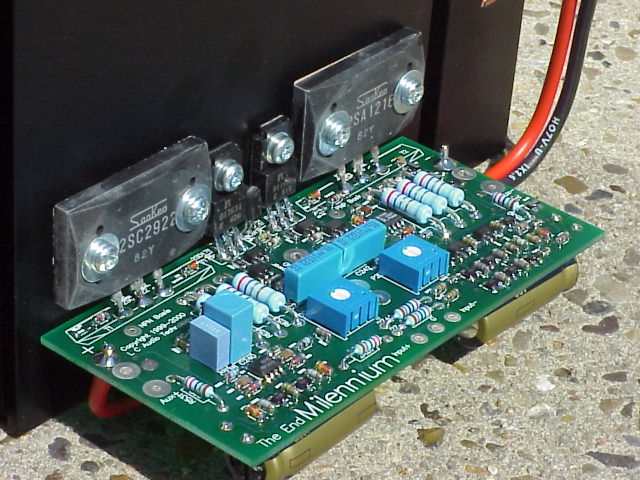
New yr 2k release of our Class A/B Power Amplifier kit of 100 to 300
Watts (in 8 Ohm).
More than 3500 of this amp sold in the previous version (Mk3) makes
it the most successful Scandinavian audio kit ever.
In this new version there are improvements on all major points:
- Extra Driver stage (now 4) improves bass control.
Glass Substrate Resistors improve linearity and reduces 3rd order distorsion.
Amplification is now performed in (the renowned) Z-Transistors, with ultra-low capacitance: 6 pF.
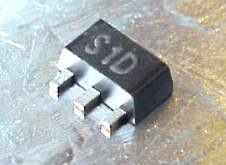
Ultra Linear Core Non Feedback circuitry improves homogenity in the
soundstage.
Included Polypropylene Capacitors ensures crystal clear treble reproduction.
All Audio Related traces on the Printed Circuit Board is made in a
special soft-curve technique that reduces standing waves, compared to traces
with sharp edges. This significantly improves resolution in the mid and
high regions.
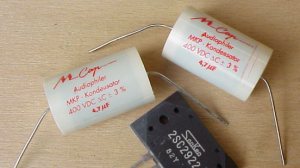
Furtermore there is on-board DC Servo (one point 2nd order type,
detachable) and effective short circuit protection. A new bias system with
signal amplifiers specified to +/- 100 Volt, makes The End Millennium perfectly
safe for operating at our limit: +/- 70 Volts and results in output power
of up to 250 Watts in 8 Ohms. The circuit is also stable down to just +/-
15 Volts, and can then operate at only 6 Watts of output power.
In bridge mode up to 1000 Watts in 8 Ohms and 2000 Watts in 4 Ohms
can be achieved with no conversion circuits. This is owing to Millennium's
input circuitry with both positive and negative signal inputs. Also suitable
for balanced XLR connection. (The Common Mode Rejection is better than
90 dB).
No IC's are found in the signal path, (only used for DC servo and Short Circuit protection), no feedback loops at all, not even local ones, makes this amplifier sound great with any type of speakers.
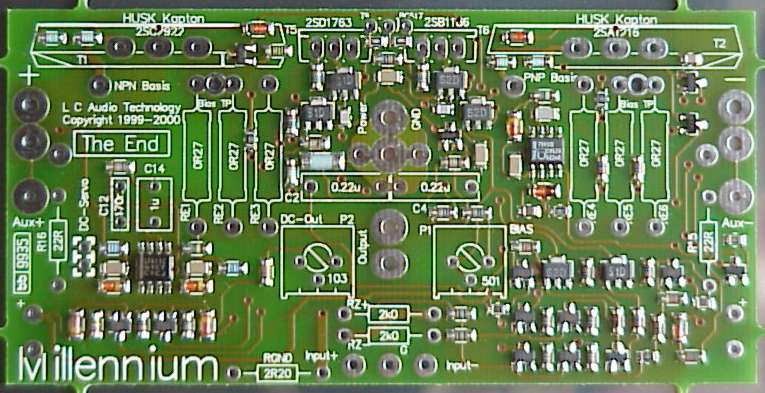
Principle of Operation.
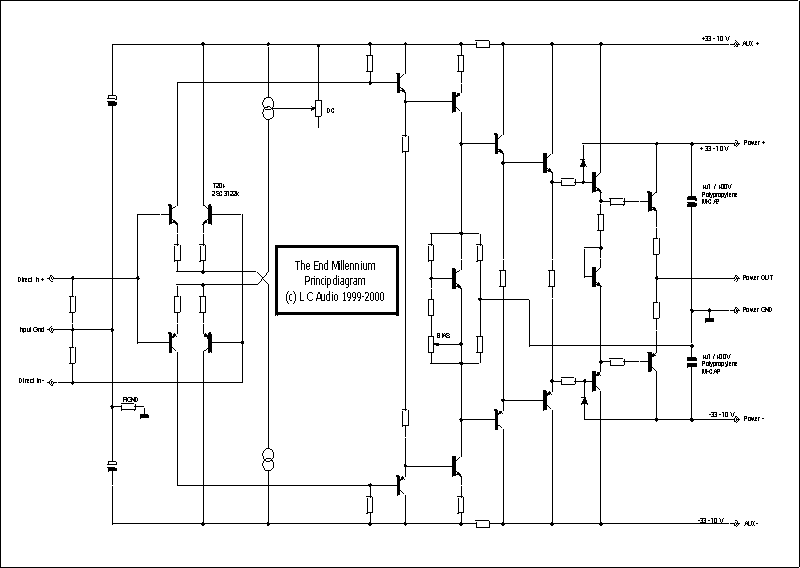
The Principle Schematic shows just how simple and ingenious this amplifier is designed. No feedback loops (100% non-feedback), no capacitors or IC's in the signal path. The frequency response stretch from DC to 500.000 Hz ( +0-3dB ), so any music signal from the deepest bass to the highest air, will flow freely through The End Millenium, to reach Your ears.
The Short Circuit protection does not affect the signal. It only monitors the currect consumed by the speakers. In case of an overload, the signal is shut down for a few seconds. Then The End tries to get back on line, but if there is still a short, it just goes off for another few seconds. If the short remains, the amplifier will wait for days, until load conditions are acceptable. Then it will play as if nothing happened! This is a very effective overload protection system, that we copied from our line of professional PA amplifiers.
Thanks to the new amplifier construction, which in several ways is ground-breaking
Technology, we can offer you a kit-form amplifier that sets the limits
for easy-flowing musicality and still with high grade audio precision.
This is features You would normally have to pay up to 10 times higher
prices for, compared to what The End Millennium cost, partly because You
assemble it Yourself, saving labor cost.
100% non-feedback = 100% musicality!
The warm - almost triode like - sound stage is owing to the absence of feedback loops in the amplifier's signal path. This principle of operation is called non-feedback, and is also used in some very expensive American Amplifier brands.In a normal Amplifier the signal is sent into a high gain (typ. 100.000), high distorsion signal amplifier. A circuit monitors what comes out of the amplifier, and compares it with the input signal. If there is a difference, a negative correction signal is sent through the amp, to eliminate the error. The problem with this approach is that - speaking in simplified terms - that it takes some microseconds for the signal to pass through the amplifier, so the comparison is made between the fresh input signal, and a few microsecond old output signal. The signal could very well have changed in this period, making it impossible for the amplifier to track the signal 100% correct. In the same manner it takes the correction signal a few microseconds to reach the output of the amplifier, where the error is encountered, so actually the amplifier is comparing a signal that occurred some microseconds earlier, against a fresh input signal, and corrects it yet a few microseconds later. It is obvious that this is bound to give problems, when more complex signal are to be amplified, to give a demanding result quality.
In simpler words You can say, that an error can not be corrected before it occurs, and then it is in fact - too late! That is why we do not use feedback loops in our amplifiers!
Using sinewave analysis of the amps performance is a thankful task,
since a sinewave - theoretically - contains the least possible amount of
slewrate per Volt signal amplitude.
Music is very much more complex and hard to reproduce.
What You hear!
In sound quality terms this would take effect in a way that makes the amp. sound thin and hard when turning up the level, and have also a substatial loss of detail, at higher levels compared to lower levels. This is because the amount of errors to correct obviously increase with output power.In non feedback amplifiers there is no circuits to compare the input
with the output signal. Therefore the designer must make sure that no distorsion
ever occurs in any stage of the amplifier. This calls for use of the most
linear and high-grade components available in the world. Instead of the
high-gain high distorsion amplifier setup normally used, a non-feedback
amplifier would consist of 2-3 stages of low gain and low distorsion, cascaded
to make the appropriate total amplification.
This type of amplifier does not have the problems explained above,
and will sound exactly the same at high and low levels. Furtermore it will
add better bass control to Your speakers, and make them perform their best.
This is because when the membranes demand power to accellerate or decellerate,
this is delivered directly from the output stage at once. It is not supplied
of a result of higher current - higher correction through the entire amplifier
circuit.
In a normal loop feedback amplifier, the extra current has to be supplied
as a result of keeping the output voltage at the right level compared to
the input voltage, through the feedback loop.
I think by now You understand the advantages of the non-feedback technique.
To avoid the need for distorsion correcting feedback loops we use the
most linear Power Transistors in the World: 2SA1216 / 2SC2922 from SANKEN.
It is a ring emitter type with just 70 mOhms of emitter impedance. You
may have read, that a MOSFET is the most linear semiconductor. However
if you take a close look at any datasheet of a MOSFET You would have to
realise, that this claim is very far from the truth. You can find datasheets
from the world leader of MOSFET's here.
| Compare Z-out Linearity (Ohms) | ||
|---|---|---|
| Output Current | MOSFET IRFP150 | Bipolar 2SC2922 |
| 100 mA | 0.8 | 0.2 |
| 500 mA | 0.4 | 0.10 |
| 1A | 0.2 | 0.09 |
| 5A | 0.066 | 0.08 |
| 10A | 0.04 | 0.07 |
The Mosfet impedance is determined by the pure theoretical properties of a MOSFET structure, so no matter which brand or type, you were to use for the comparison, it would give you the exact same results.
In a faily large amplifier, the output current would constantly change in values between 0 and 10 Amperes, as the output signal changes. The unlinearity, defined as the changing in the Z-out, which is in series with the speakers, changes by a factor of 20 for the Mosfet, but only by a factor of less than 3 for the ring-emitter type. Thus the distorsion coming from the output device is more than six times higher for a MOSFET, than the Ring Emitter type used in The Millennium. The MOSFET gains linearity for high currents, making it more linear only in super-high current Class A modes, such as found in single-end output stages. From the above scheme You can find that the MOSFET gets better at a bias current of more than 5 Amperes. But to construct a Class A amplifier with a MOSFET and this high bias current can - due to practical maximum power dissapation of 70 Watts - only have a supply voltage of +14 V, giving as little as 12 Watts of output power in 8 Ohms. And then the MOSFET would only be slightly more linear than the Ring Emitter.
MOSFET's are only 'linear' in some manufacturors leaflets. (The true
advantage of MOSFET components in real life is: lower price per Watt of
output power).
Building up to higher Power Levels.
The End Millennium is intended for a voltage of +/- 45 Volts made with a 2 X 33 V transformer. This gives You about 100 Watts in 8 Ohms output power. A small auxillary supply for the driver stage, making it run at a little higher voltage, gives You an extra 20 Watts in 8 Ohms, (Total 120 Watts) actually with less heat sink loss. The End Millennium is prepared for use of this AUX supply.It is also prepared for running at higher voltages with higher output power capabilities. A module with an extra set of power Transistors, and the surrounding components, allows for a +/- 58 V supply from a 2 X 40 V transformer, to give power of 180 Watts into 8 Ohms.
Most amplifier manufacturors would just parallel the output transistors to give the higher power, but we find this method has important flaws. Parallelling power devices is like building a car with a total of 300 HP by putting in two engines of each 150 horsepower. It could work, but coordination problems are inevitable. In power amplifiers parallelling of Output devices, produces high order (very unpleasant sounding) distorsion. Instead we recommend having the main board run the treble / midrange speakers, and any extra output boards run the bass on a separate output terminal.
This approach works very well for solving the sound quality problems, but is dependant on the speakers having bi-wiring connection. (Most good speakers have).
Technical Data.
| Output Power into 8 Ohms | 120 Watts |
| Output Power into 4 Ohms | 240 Watts |
| Output Power into 3 Ohms | 300 Watts |
| Frequency Response +-3dB | DC-500.000 Hz |
| Phaseshift @ 20.000Hz | max. 2 deg. |
| THD -3dB | 0,0017% |
| Peak Current 1 mS | 46 Amperes |
| Output Impedance | 150 mOhm |
| Damping Factor (50 - 15.000 Hz) | 53 |
| Equivalent input noise | 20 uV RMS |
| Signal / Noise Ratio | min. 110 dBA |
Building a complete Amplifier.
However we have put together a few typical systems for Your easy overview, and listed the prices for each part.
The End Millennium Parts.
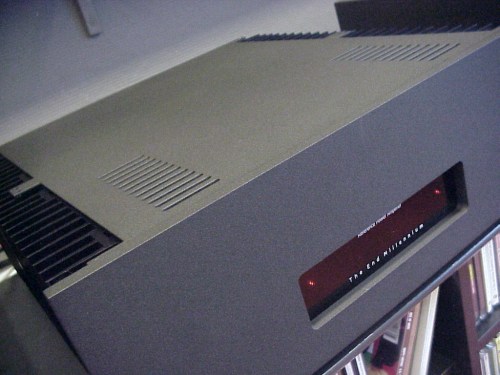

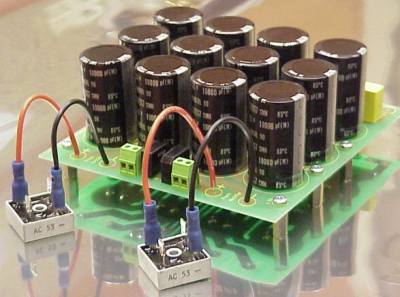
In a normal power amplifier, where the small signal stages run on the main power supply, the signal and speaker impedance, would cause load dependant distorsion.